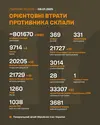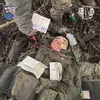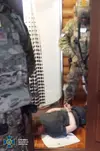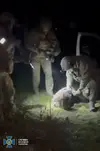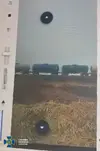Install the app
How to install the app on iOS
Follow along with the video below to see how to install our site as a web app on your home screen.
Note: This feature may not be available in some browsers.
You are using an out of date browser. It may not display this or other websites correctly.
You should upgrade or use an alternative browser.
You should upgrade or use an alternative browser.
Ukrainan konflikti/sota
-TripleX-
Respected Leader
Ryssien viestikalustomiehen loppu. Näitäkään ei mobikeilla korvata.
Lgovin iskun satoa tulee ilmoille tipoittain, kahden everstiluutnantin lisäksi siellä meni Pihkovan majurikin.
Lgovin iskun satoa tulee ilmoille tipoittain, kahden everstiluutnantin lisäksi siellä meni Pihkovan majurikin.
Viimeksi muokattu:
Operatiivinen tilannetiedote 08.00 8.1.2025 koskien Venäjän hyökkäystä

 t.me
t.me

 t.me
t.me

 t.me
t.me

 t.me
t.me
Kunnia Ukrainalle!
Tänään on alkanut Venäjän federaation laajamittaisen aseellisen aggression 1050. päivä Ukrainaa vastaan.
Eilisen vuorokauden aikana kirjattiin yhteensä 176 taistelukosketusta.
Vihollinen teki 45 ilmaiskua Ukrainan joukkojen asemiin ja asutuskeskuksiin, pudotti 93 tarkkuuspommiasejärjestelmää (KAB) ja käytti lisäksi 2021 itsemurhalennokkia. Lisäksi vihollinen suoritti noin 5000 tykistökeskitystä, joista 139 raketinheittimillä.
Ilmaiskuja kohdistettiin erityisesti seuraaviin asutuskeskuksiin Donetskin alueella: Serebrjanka, Verhniokamjanske, Dyliivka, Toretsk, Katerynivka, Petrovka, Pokrovsk, Stepove, Kostjantynopil, Rozlyv, ja Velyka Novosilka.
Ukrainan puolustusvoimien ohjus- ja tykistöyksiköt iskivät viime vuorokauden aikana kahdeksaan alueeseen, joissa vihollisen henkilöstöä, aseistusta ja sotakalustoa oli keskitetty, sekä yhteen miehittämättömien ilma-alusten komentopaikkaan.
Tilanne eri rintamasuunnilla:
• Harkovan suunta: Vihollinen yritti turhaan edetä neljä kertaa Vovtšanskin ja Tykhyn alueella.
• Kupjanskin suunta: Kolme vihollishyökkäystä torjuttiin Topolin, Holubivkan ja Petropavlivkan lähellä.
• Lymanin suunta: 14 vihollishyökkäystä, etenemisyrityksiä mm. Novoserhiivkan, Nadiian, Pervotravneven ja Ivanivkan alueilla.
• Siverskin suunta: Seitsemän hyökkäystä torjuttiin Bilohorivkan alueella.
• Kramatorskin suunta: Seitsemän hyökkäystä Vasjukivkan, Bondarnen, Tšasiv Jarin ja Bilan Horan alueilla.
• Toretskin suunta: Yhdeksän hyökkäystä, joista osa ilmatukien avulla, kohdistui Toretskiin.
• Pokrovskin suunta: 41 vihollishyökkäystä torjuttiin useissa kylissä, kuten Tarasivkassa, Vodyane Druhessa ja Pokrovskissa.
• Kurahevkan suunta: 25 hyökkäystä torjuttiin Sribnen, Slovjankan, Petropavlivkan ja Kurahevon lähellä.
• Vremivkan suunta: 21 vihollishyökkäystä, aktiivista lentotoimintaa mm. Jantarnen ja Privilnen alueilla.
• Pridniprovskin suunta: Kaksi vihollishyökkäystä torjuttiin onnistuneesti.
• Orikhivin ja Huljajpilen suunnat: Ei merkittäviä vihollistoimia.
• Volynin ja Polissjan suunnat: Ei merkkejä vihollisen hyökkäysjoukkojen muodostamisesta.
Kurskin alueella operaatio jatkuu. Viime vuorokauden aikana kirjattiin 32 taistelukosketusta, ja vihollisen tykistö teki 146 iskua.
Vihollisen tappiot viime vuorokauden aikana:
• 1660 henkilöä
• 4 tankkia
• 16 panssaroitua ajoneuvoa
• 19 tykistöjärjestelmää
• 19 miehittämätöntä ilma-alusta
• 81 ajoneuvoa
Liity puolustusvoimiin!
Yhdessä voitamme! Kunnia Ukrainalle!

Генеральний штаб ЗСУ
Оперативна інформація станом на 08.00 08.01.2025 щодо російського вторгнення Слава Україні! Розпочалась тисяча п'ятдесята доба широкомасштабної збройної агресії російської федерації проти України. Загалом, протягом минулої доби зафіксовано 176 бойових зіткнень. Вчора противник завдав по...
Ukrainan puolustusvoimat iskivät venäläiseen öljyvarastoon Engelsissä
Tänä yönä iskettiin öljytuotteiden varastointikeskukseen “Kombinat Kristal”, joka sijaitsee Engelsissä, Saratovin alueella.
Kohdealueella havaittiin useita räjähdyksiä, ja paikalle syttyi laaja tulipalo. Paikallisviranomaiset vahvistavat osuman “teollisuuskohteeseen”.
On syytä huomata, että tämä öljyvarasto toimitti polttoainetta Engels-2-sotilaslentokentälle, jossa Venäjän vihollisen strateginen ilmailu sijaitsee.
Tarkempia tietoja taisteluoperaation tuloksista täsmennetään.
Tehtävän suorittivat Ukrainan puolustusministeriön pääesikunnan tiedusteluyksiköt ja Ukrainan asevoimien miehittämättömien järjestelmien joukot yhteistyössä muiden puolustusvoimien osastojen kanssa.
Öljyvaraston tuhoaminen aiheuttaa vakavia logistisia ongelmia Venäjän miehittäjien strategiselle ilmailulle ja heikentää merkittävästi heidän kykyään iskeä rauhanomaisiin ukrainalaisiin kaupunkeihin ja siviilikohteisiin.
Jatkoa seuraa…
Kunnia Ukrainalle!

Генеральний штаб ЗСУ
Сили оборони України уразили російську нафтобазу в Енгельсі Сьогодні вночі атаковано базу зберігання нафтопродуктів “Комбінат Крістал”, що в Енгельсі Саратовської області. В районі цілі фіксувалися численні вибухи, здійнялася масштабна пожежа. Місцева влада підтверджує влучання в...
SSO tuhosi Pohjois-Korean sotilasryhmän Kurskissa
Ukrainan asevoimien 8. erikoisoperaatiorykmentin operaattorit tuhosivat 13 Pohjois-Korean sotilasta.
Erikoistoiminnan aikana SSO:n sotilaat eliminoivat viisi Pohjois-Korean sotilasta jalkaväentaistelussa ja kahdeksan lisää droonien avulla.
Taistelun jälkeen SSO:n operaattorit tarkastivat Pohjois-Korean sotilaiden ruumiit ja heidän henkilökohtaiset asiakirjansa. Yhdeltä sotilaalta löydettiin kolimaattoritähtäimellä varustettu rynnäkkökivääri, kiinalais-venäläinen “Azart”-radiopuhelin sekä droonien tunnistin. Lisäksi hänellä oli erillinen asiakirja, joka poikkesi tavanomaisesta sotilaspassista. Löydetyt esineet voivat viitata hänen kuulumiseensa upseerikuntaan.
Muun muassa yhdellä Pohjois-Korean sotilaalla oli mukanaan kirje, joka oli osoitettu puolueelle.
Jatkamme työtä.

Сили Спеціальних Операцій ЗС України
ССО знищили групу військових КНДР на Курщині Оператори 8-го полку Сил спеціальних операцій ЗС України знищили 13 військовослужбовців Північної Кореї. Під час виконання спеціальних дій воїни ССО «задвохсотили» п’ять бійців КНДР у стрілецькому бою та ще вісьмох за допомогою дронів. Після бою...
Korealaiset alkavat vähitellen päästä jyvälle.
Kurskin ulokkeen pohjoisosassa vihollinen on saavuttanut edistystä viime päivien aikana. Tämä johtuu siitä, että ensimmäistä kertaa käytettiin sekaryhmiä, jotka koostuvat venäläisistä ja korealaisista rynnäköijistä. Olen aiemmin maininnut useasti, ettei korealaisille annettu radiopuhelimia, mutta eilen tai toissapäivänä heidät havaittiin jo niiden kanssa, eli nyt heillä on yhteydenpitomahdollisuus.
Hauskana yksityiskohtana pojat kertovat, että tällaisissa ryhmissä korealaisilla on eräänlainen “johtohahmo”, joka juoksee pienen kellon kanssa, huutaa jotain koreaksi ja yrittää kerätä heitä yhteen. Näyttää siltä, etteivät he täysin ymmärrä, miksi heille annettiin radiopuhelimet.
Upseeri ✙

Офіцер ✙
Корейців потроху починають роздупляти. На півночі Курського виступу ворог має просування за останні декілька днів. Повʼязано це з тим, що вперше були застосовані змішані групи, які складаються з російських та корейських штурмовиків. До цього я неодноразово зазначав, що корейцям не видавали...
Antares
Respected Leader
Koneiden lentotunnit alkavat täyttymään, ja toivottavasti samaa rataa koko maan

Lähes puolet Moskovan taistelukoneista on elinkaarensa lopussa | Verkkouutiset
Lähes puolet Moskovan taistelukoneista on elinkaarensa lopussa | Verkkouutisetwww.verkkouutiset.fi
Tuossa Verkkouutiset artikkelissa on viitattu mm. puolalaiseen Defence24 artikkeliin joka on julkaistu 17.7.2024.
En muista että sitä olisi nähty tässä ketjussa, tosin ehkä muistan väärin. Ansiokas ja ajatuksia herättävä artikkeli joka tapauksessa, varsinkin kun samalta kirjoittajalta on nähty aikaisempi, 24.8.2021 julkaistu artikkeli jossa ennakoitiin ryssän ilmavoimien "jyrkän laskun" alkavan:
The Russian Air Force. The Last Moments Before the Great Regression "
Russian Air Force: The Last Moments Before the Great Regression [OPINION]
Russian Air Force: The Last Moments Before the Great Regression [OPINION]

MACIEJ SZOPA
24/08/2021 07:18

MiG-31BM / Photo: mil.ru
The Russian Air Force still holds the position of the world's second air power, but its position is getting weaker with each passing year. Hundreds of aircraft inherited from the Soviet Union will inevitably have to retire, and there will be nothing to replace them with. For financial, technical and because of the weakness of the Russian industry.
At the beginning of this year, the Russian Aerospace Forces had 380 heavy fighters of the Su-27 family, 267 light fighters of the MiG-29 family of various modifications, 131 MiG-31 interceptors, 274 Su-24 and 125 newer Su-34 front-line bombers, and 193 Su-25 combat aircraft, for a total of 1,370 aircraft. Adding 124 heavy bombers (16 Tu-160s, 42 Tu-95s, and 66 Tu-22Ms) and 91 naval combat jets (22 MiG-29K/KUBs, 43 Su-27/33s, 22 Su-24s, and 4 Su-25s) gives an impressive total of 1,585 aircraft, which puts Moscow among the world leaders – ahead of the People's Republic of China, although quite far behind the armed forces of the United States.
These numbers look much less impressive when we realize that a significant part of this potential are aircraft acquired as inheritance from the Soviet Union. As we know, this power fell in 1991, i.e. 30 years ago. Three decades is very often the time when the designed service life of combat aircraft ends. Such as the MiG-29s, which are still used, but with great difficulty and to a limited extent in Poland. However, production of the MiG-29s began much earlier - in 1981. Some of the aircraft in Russian service may therefore be between 30 and 40 years old.
Of course, aircraft can be subjected to far-reaching and expensive life-extending procedures, as the Americans are doing by extending the life of their 4th generation aircraft. However, in the case of the fleet of 289 MiG-29s, similar procedures were carried out in the years 2009-2020 on only 74 aircraft – 24 naval variants and only 50 land variants, and this includes a dozen or so “new” aircraft produced for export, which Algeria did not accept (because, contrary to the agreement, they were based on used airframes).
This means that over 200 of these aircraft have not undergone any treatment or have undergone very limited treatment, and their condition may not be much better than the thirty Polish "Fulcrums", some of which are currently grounded and some perform very limited tasks. The issue of the MiG's successor is also problematic. The MiG-35 does exist, but orders have been placed for only six examples of this aircraft and they will probably serve only in aerobatic teams as a living advertisement aimed at selling this design on export markets. The Russians do not have an optimal light fighter for themselves, and its successor - perhaps in the form of the single-engine Su-75 Checkmate - is a matter of the distant future and it is difficult to even talk about specific dates here, apart from the fact that this aircraft will not enter production until the 1930s at the earliest.
The fleet of front-line bombers looks only slightly better. Over the course of a decade, the Russians managed to build 127 Su-34s, equivalent to the American F-15E Strike Eagles, but 296 venerable Su-24s remain in service. These machines were manufactured between 1967 and 1993, so even the youngest of them are currently approaching 30. The situation is not entirely saved by the Su-34s, even considering that their current number will be joined in the coming years by another 30 from the current order. Even if funds were found for more, the Russians were only able to build a maximum of 18 of these machines per year in the past decade, with the peak of production occurring in the mid-2000s, and in recent years only a few machines have been built. An additional replacement for the Su-24 is the construction of multi-role Su-30 fighters, but only 134 of them have been built in total, and using them as a replacement for them will distract them from other tasks.
The fleet of heavy fighters of the Su-27 family looks relatively the best, with 134 Su-30s and 98 of the 128 ordered Su-35s built for our own armed forces in the last decade. To this should be added 22 thoroughly modernized Su-27s, which gives a total of 247 aircraft that can serve for a relatively long time, representing a relatively satisfactory technical level. However, the current fleet of Russian fighters of the Su-27 family consists of 380 aircraft. This means that over 130 are old aircraft that will have to be replaced in the near future. 30 of them will replace the not yet produced Su-35S. What will replace the next hundred? The answer is the theoretical Su-57. However, this will happen if their serial production does not experience further delays. So far, 78 of these aircraft have been ordered and are to be delivered over the next 7 years, and only one has been delivered, even though the Su-57 (PAK-FA) program has been ongoing for a dozen or so years.
The fleet of MiG-31 interceptors is struggling with problems. The last one left the factory in 1994, making it 27 years old. These aircraft are being modernized to the MiG-31BM or MiG-31K variant, carrying the "hypersonic" Kindzhal missiles. However, this does not change the fact that most of these machines are already over thirty and their operational capabilities will be exhausted. The only solution to this situation can be the program of their successor, which is to be the result of the PAK-DP program, i.e. the so-called "space-friendly" MiG-41. In view of the problems of the Su-57 program, it is not known when such an aircraft could be built and whether it will not encounter technical problems, for example with engines, as was the case with the PAK-FA program. Will there be suitable technologies for it, which are lacking for engines for the Su-57, and will the exorbitant financial resources be found?
The battlefield aviation using the Su-25 is also in a relatively difficult situation. The Russians currently have 197 such machines in service. And although their official production line is still operating and development variants of this design are being proposed, since 2010 not a single brand new platform of this type has been delivered to the armed forces of the Russian Federation. It is possible that the solution here will be the Yak-130 training and combat aircraft, of which the Russian armed forces managed to deliver 113 units between 2010 and 2020. However, it is more likely that their successors will be attack drones - MALE class and innovative jet BBSP such as the S-70 Okhotnik created in the flying wing configuration.
Strategic bombers also do not have a ready successor. The Tu-22M was built for a relatively long time, until 1997, but the plans to create their successor are not entirely specific. The Russians are conducting a program for a new generation bomber PAK-DA, the first flight of the prototype of which has been announced for 2023. This date seems highly optimistic, but even a timely prototype flight could mean years of work before these machines enter service. Meanwhile, the PAK-DA, alongside the Tu-22M, would also replace the heaviest Tu-160 bombers in the long term. Production of these machines has been resumed, but so far only one or two units have been delivered, and all based on components that date back to the USSR.
The decline is also visible in the aviation supporting combat aircraft. Russia currently has 15 early warning aircraft, of which one was delivered in the last 10 years. In turn, out of 19 Il-78 aerial refueling machines, six of which were delivered in the last 10 years. Meanwhile, in the fleet of 114 Il-76 transport aircraft, less than a decade old, there are only six aircraft, and an attempt to revive the construction of heavy An-124 Ruslans ended in failure.
As we can see, the pace of replacing old aircraft with new ones in the Russian Air Force and Navy, although sometimes held up as an example compared to the US Air Force struggling with generational replacement, in reality leaves much to be desired. Building 4+ generation aircraft is not, as some would like, a wise alternative to the "unwise" program of building 5th generation multirole aircraft F-35 or F-22, but rather an expression of the inability to produce more advanced designs.
Despite all these investments and financial efforts – which have led to the introduction of almost 400 new or thoroughly refurbished combat aircraft into Russian service over the past decade – it seems that maintaining its current numbers will not be possible.
Decline in numbers
This will not be the case even for the "reinvested" heavy multi-role and air superiority fighters, which have received the largest outlays. Their fleet will be reduced at most by a small amount (10-20%). However, in the face of the PAK-FA program and the commenced serial production of the Su-57, the situation does not have to look so bad. Much more radical reductions will apply in the near future to strike aviation, which currently has almost 300 old-type aircraft (Su-24) and only slightly over 100 new ones (Su-34). A complete collapse may occur in the case of light fighters due to the lack of a ready successor to the MiG-29, which, despite recent grand announcements related to the Su-75, will not have a successor for a long time. In turn, the MiG-35 as a successor is both an expensive solution (two engines) and not a promising one, with parameters comparable to the F-16 Block 70/72 at best. The situation is similar for interceptors, although the modernization of the MiG-31BM will extend their functionality for some time.
New constructions
Currently, the Russian Federation Air Force relies solely on projects from the Soviet era, which at best are generation 4+. The only exception is the troubled Su-57, which may be able to raise heavy fighter platforms to generation 5. However, the remaining programs (Su-75, PAK-DA, MiG-41), as well as others, such as the new transport aircraft PAK-VTA, or Il-106 Slon, seem unrealistic to implement, at least in the near future. In some cases for technical reasons, and in all for financial reasons.
Neither the United States nor the People's Republic of China could conduct all of these programs at the same time due to the costs. Especially if they were to end with solutions comparable to the American one. The cost of research and development programs is one thing today, and ordering hundreds of new aircraft is something completely different, so that it is possible to replace aging structures on a 1:1 scale, whose resources will end in this decade.
The export prospects, finding prospective, reliable customers or even partners in programs could be a chance. Such ventures have so far failed, however, especially in the era of the American embargo on countries importing products of the Russian arms industry - it is enough to mention here the attempt to create a fighter for India under the HAL FGFA program based on the PAK-FA or the announcements of creating a "light fighter" together with the United Arab Emirates based on the MiG-29.
Decline in numbers and importance
It seems that in the near future we will be dealing with a significant reduction in the number of Russian military aviation, forced by the lack of both appropriate technical solutions and financial resources. There will be a significant reduction in the number of front-line bomber units (even by 50 percent), even the disappearance of lighter front-line fighter units (based on the MiG-29) and, at best, stagnation when it comes to interceptors. The missing aircraft may be at least partially replaced by unmanned combat platforms, such as the S-70 Okhotnik, which flew in 2018 and is already being tested, or simpler MALE-class designs. Despite this, it seems that Russia's power projection capabilities, despite ruffling feathers at subsequent military parades, are and will be significantly reduced.
The condition of Russian aircraft, combined with finances, also affects the preparation of Russian pilots, who currently fly significantly fewer hours per year than their "colleagues" from NATO or China. This may have a positive effect on the number of air accidents, which have also been relatively numerous in the last decade. From combat aircraft alone, Russia has lost 46 aircraft since the beginning of 2010, including 8 brand new ones : 11 Su-24s, 10 MiG-29s (including two lost by mercenaries in Libya), 7 Su-27s, 6 Su-25s, 3 Tu-22s, 3 Su-30s, 3 Su-34s, 1 Su-35S, 1 Su-33 and 1 Su-57. These calculations constitute a dozen or so percent of the production of new aircraft, even though they only take into account the revealed irretrievable losses, including combat losses, but not damage and wear, which in the long term may also contribute to the withdrawal of aircraft.
Tämän artikkelin teesi oli se että valtaosa ryssän ilmavoimien kalustosta on Neuvostoliiton aikana valmistettua ja samalla heidän teollisuuden uustuotanto ei kykene korvaamaan kalustoa samaa tahtia kuin mitä sitä poistuu käytöstä (teoreettinen "kirjavahvuus" voi sanoa yhtä mutta todellisuus toista: hän ennakoi ennen sotaa julkaistussa artikkelissaan että edessä on "jyrkkä lasku" konemäärien osalta, mikä tarkoittaisi samalla suorituskyvyn laskua vaikka uudet konemallit ovatkin selvästi parempia kuin vanhat).
-
Venäjän ilmavoimissa artikkeli koettiin niin vastenmielisenä että sitä piti kommentoida julkisesti (se koira älähtää johon kalikka kalahtaa?), mihin artikkelin kirjoittaja vastasi toisessa 3.9.2021 julkaistussa kirjoituksessaan:
https://defence24.com/russian-respo...bout-the-russian-military-aviation-commentary
Russian Response to Defence24.pl Article: What is Truth about the Russian Military Aviation? [Commentary]
-
Lisäksi hän on julkaissut yhden artikkelin 19.4.2022 eli vajaa kuukausi hyökkäyksen alkamisen jälkeen:
THE REGRESSION OF THE RUSSIAN AIR FORCE - Maciej Szopa
Artikkelissa todetaan että Ukrainassa on pääasiassa käytetty uudempaa kalustoa (ja vähemmän Neuvostoliiton aikana valmistunutta), mikä kertonee pari asiaa:
1) vanhempien koneiden kunto voi olla paljon oletettua huonompi, jopa sellainen että niillä on vaarallista lentää jo nyt, ja
2) valtaosa menetetyistä koneista on tietysti täten uudempaa tuotantoa, mikä puree kahta kauheammin tällaisiin ilmavoimiin.
Se voi olla syynä varovaisemmalle lentotoiminnalle (pommitus korkealta rautapommein tai oman rajan takaa) - jokainen uusi kone alkaa olemaan kullan arvoinen ja jokainen menetys tuntuu pahasti. Näin siis arvioitiin hyvin pian hyökkäyksen alkamisen jälkeen, mistä on kohta kolme vuotta aikaa.
-
Lainaan 17.7.2024 julkaistun artikkelin käännöksen spoilerin taakse, nimensä mukaisesti se on tilannekatsaus ryssän ilmavoimien tilasta 2,5 vuotta jatkuneen suursodan jälkeen (huomautan että artikkelin julkaisusta tulee tasan kuusi kuukautta yhden viikon kuluttua):
The State of Russian Aviation After 2.5 Years of War [ANALYSIS]
https://defence24.pl/wojna-na-ukrai...osyjskiego-lotnictwa-po-25-roku-wojny-analiza

MACIEJ SZOPA
17.07.2024 08:56

Autor. mil.ru / Wikimedia Commons
In a recent speech, the Ukrainian president demanded 128 F-16s from the West, arguing that the Russians use an average of 300 combat aircraft against his country every day. This is an interesting contribution to the discussion of the state of Moscow's air force today.
At the turn of 2019 and 2020, a scandal arose in Poland regarding the efficiency of Polish F-16 Jastrząb. It resulted from the fact that journalists from a certain media outlet asked how many planes were ready for immediate intervention. In response, they heard that there were four. Of course, they meant two pairs on duty. This was wrongly (?) interpreted as the number of planes capable of conducting operations. In February 2020, we conducted our own investigation . It turned out that the level of efficiency of the F-16s at that time reached around 60 percent, which was not the worst result in NATO, whose members had F-16 fleets with operational readiness between 40 (Greece) and 70 percent (USA).
How does this indicator look in the Russian Air Force? Before the outbreak of the war in Ukraine, it was believed that the readiness of the Air Force aircraft for combat operations was much lower than in NATO. It was estimated at 30-40 percent. This was due to: the low level of technical culture in Russia (and the resulting maintenance according to the calendar, not according to the condition of the machine), lack of funds for proper aircraft maintenance, widespread corruption, and poor infrastructure, which often forces aircraft to be kept "in the open air" instead of in air-conditioned hangars.
The problem is also the equipment itself. While American combat aircraft were built with planned service lives of 6-8 thousand hours in the air, and currently there are programs to extend them to 12 thousand hours or more, Soviet and later Russian aircraft were designed for 4 (MiG-29) or 5 thousand (Su-27) flight hours.
The average age of these aircraft is also questionable. Of the approximately 1,200 platforms, approximately 550 are approaching the end of their life cycles. These include Su-24 family frontline and reconnaissance bombers, Su-25 combat aircraft, MiG-31 interceptors, and MiG-29 and Su-27 air superiority fighters. Of the types listed above, only the Su-25 is used intensively in Ukraine, which is because there is simply no substitute for it.
Meanwhile, according to information from available sources, the MiG-29 is not used in war at all, so it is only on paper. It is also rarely encountered in other parts of the world by NATO aircraft and countries friendly to the North Atlantic Alliance. The Su-27 performs support and defensive operations. It was these machines that were left "under the bombs" in Crimea, where they had already been bombed many times with an effect that was difficult to determine (however, there were frequent reports of alleged damage in Ukrainian strikes to "several machines").
The MiG-31 is also used for support operations. Many of them were based in Crimea, at least until two such aircraft were destroyed in a Ukrainian attack. The last Su-24 was shot down by the Ukrainians in December 2023. Despite previous intensive use, there has been no news of these bombers on the front since then. It is speculated that these machines were not integrated with glide bombs with UMPK modules. Given the poor prospects (read: huge wear and tear of the airframes) and poor modernization potential, the Su-24 should be withdrawn from service soon.
The mere retirement of the Su-24s of all versions would reduce Russia's combat jet fleet (as shown on paper) by about 270 aircraft, from about 1,200 to 930. If we subtract the apparently worthless (because neglected) MiG-29s from the total, the number drops to about 850 aircraft.
The list of machines remaining in service therefore includes:
President Zelensky's claim that Russia uses an average of 300 aircraft against Ukraine every day seems like a realistic estimate in this situation. It seems that Moscow is using most of its fleet in the war, the real number of which is 850 aircraft.
The question is operational readiness. Russians are certainly less concerned with the issues of crew resources and safety than Western pilots. The funds allocated to the production of spare parts are growing, and Russian technical personnel are also working harder. However, this does not compensate for negative phenomena such as excessive wear due to increased flight time, more intensive use resulting from much more frequent flights than in peacetime (also due to a much greater number of take-offs and landings that burden the structure), as well as faster wear of airframes and engines due to performing rapid maneuvers during combat flights.
Michael Bohnert, in a March 2024 Defense News article (also cited by RAND), estimated that due to operational attrition alone, the Russians will have to retire about 60 combat aircraft this year. And that’s not counting the Ukrainians shooting down and destroying Russian aircraft at their bases.
In the first six months of this year, the Ukrainian side published evidence of the complete destruction of 12 aircraft: one Tu-22M3 strategic bomber, one Su-57, three Su-34 front-line bombers, two Su-35 fighters, three Su-27 fighters and two MiG-31 interceptors. To this number we can add the destruction of two A-50 early warning aircraft. The Ukrainians claim that they have destroyed many more aircraft. Although there is no documentation to prove it today, their claims may be true, especially considering the scale of attacks on Russian air bases.
In addition, there are losses resulting from damage to aircraft. It is really difficult to prove anything here. Numerous combat aircraft could have been damaged to varying degrees or destroyed in missile and drone strikes on Russian air bases, mainly Su-34 bombers and Su-27s exposed to bombing in Crimea.
The Russian combat aviation, which was estimated at 1,500 aircraft a few years ago, is therefore decreasing. It seems that each additional month of war reduces both the size of the fleet (due to the destruction of aircraft, damage and wear) and the prospects for using what survives in a hypothetical armed conflict with NATO or any country that Russia would like to attack (it threatens Kazakhstan, among others).
The situation is not improved by the production of new aircraft for the Russian Aerospace Forces. We have been following it closely since the beginning of the war. It seems that in 2022, the Russians managed to put into service 27 new aircraft, and in 2023 about 24. In turn, in the first six months of 2024, it seems that only six new aircraft were put into service: four Su-34M and two Su-35S.
These data indicate that Russia has not only failed to increase its modest aircraft production capacities, but that they seem to be declining. This may be because aircraft are much more difficult and complex to produce than, for example, tanks or infantry fighting vehicles, but also because, unlike them, they require many modern components, which the Russians are either starting to lack or are smuggling at exorbitantly high prices.
Everything indicates that as long as the war continues and sanctions are in force, the Russian combat aviation, although considered to have suffered relatively little damage compared to the land forces, is losing its operational capabilities and future prospects. Even if the sanctions were lifted, it would no longer be possible to rebuild Moscow's air force in its former, superpower form. The war is rather an acceleration of the collapse of the VKS, which began before February 2022. I described this process in the article entitled " The Russian Air Force. The Last Moments Before the Great Regression ".
The State of Russian Aviation After 2.5 Years of War [ANALYSIS]

MACIEJ SZOPA
17.07.2024 08:56

Autor. mil.ru / Wikimedia Commons
In a recent speech, the Ukrainian president demanded 128 F-16s from the West, arguing that the Russians use an average of 300 combat aircraft against his country every day. This is an interesting contribution to the discussion of the state of Moscow's air force today.
At the turn of 2019 and 2020, a scandal arose in Poland regarding the efficiency of Polish F-16 Jastrząb. It resulted from the fact that journalists from a certain media outlet asked how many planes were ready for immediate intervention. In response, they heard that there were four. Of course, they meant two pairs on duty. This was wrongly (?) interpreted as the number of planes capable of conducting operations. In February 2020, we conducted our own investigation . It turned out that the level of efficiency of the F-16s at that time reached around 60 percent, which was not the worst result in NATO, whose members had F-16 fleets with operational readiness between 40 (Greece) and 70 percent (USA).
How does this indicator look in the Russian Air Force? Before the outbreak of the war in Ukraine, it was believed that the readiness of the Air Force aircraft for combat operations was much lower than in NATO. It was estimated at 30-40 percent. This was due to: the low level of technical culture in Russia (and the resulting maintenance according to the calendar, not according to the condition of the machine), lack of funds for proper aircraft maintenance, widespread corruption, and poor infrastructure, which often forces aircraft to be kept "in the open air" instead of in air-conditioned hangars.
The problem is also the equipment itself. While American combat aircraft were built with planned service lives of 6-8 thousand hours in the air, and currently there are programs to extend them to 12 thousand hours or more, Soviet and later Russian aircraft were designed for 4 (MiG-29) or 5 thousand (Su-27) flight hours.
The average age of these aircraft is also questionable. Of the approximately 1,200 platforms, approximately 550 are approaching the end of their life cycles. These include Su-24 family frontline and reconnaissance bombers, Su-25 combat aircraft, MiG-31 interceptors, and MiG-29 and Su-27 air superiority fighters. Of the types listed above, only the Su-25 is used intensively in Ukraine, which is because there is simply no substitute for it.
Meanwhile, according to information from available sources, the MiG-29 is not used in war at all, so it is only on paper. It is also rarely encountered in other parts of the world by NATO aircraft and countries friendly to the North Atlantic Alliance. The Su-27 performs support and defensive operations. It was these machines that were left "under the bombs" in Crimea, where they had already been bombed many times with an effect that was difficult to determine (however, there were frequent reports of alleged damage in Ukrainian strikes to "several machines").
The MiG-31 is also used for support operations. Many of them were based in Crimea, at least until two such aircraft were destroyed in a Ukrainian attack. The last Su-24 was shot down by the Ukrainians in December 2023. Despite previous intensive use, there has been no news of these bombers on the front since then. It is speculated that these machines were not integrated with glide bombs with UMPK modules. Given the poor prospects (read: huge wear and tear of the airframes) and poor modernization potential, the Su-24 should be withdrawn from service soon.
The mere retirement of the Su-24s of all versions would reduce Russia's combat jet fleet (as shown on paper) by about 270 aircraft, from about 1,200 to 930. If we subtract the apparently worthless (because neglected) MiG-29s from the total, the number drops to about 850 aircraft.
The list of machines remaining in service therefore includes:
- a fleet of strategic bombers with 59 Tu-22M3, about 50 Tu-95 and 17 Tu-160 (total 126 machines);
- Su-30SM/SM2 multirole aircraft (about 120 machines);
- Su-34 front-line bombers (110-120 machines);
- Su-35S air superiority fighters (100-110 machines);
- new "5th generation" Su-57 fighters (a dozen or so machines);
- new, but only in the MiGi-35 aerobatic team (six machines);
- outdated MiG-31 interceptors (80-90 machines);
- old Su-25 combat aircraft (about 160 machines);
- the rest of the fleet of old, partially modernized Su-27s (about 100 machines).
President Zelensky's claim that Russia uses an average of 300 aircraft against Ukraine every day seems like a realistic estimate in this situation. It seems that Moscow is using most of its fleet in the war, the real number of which is 850 aircraft.
The question is operational readiness. Russians are certainly less concerned with the issues of crew resources and safety than Western pilots. The funds allocated to the production of spare parts are growing, and Russian technical personnel are also working harder. However, this does not compensate for negative phenomena such as excessive wear due to increased flight time, more intensive use resulting from much more frequent flights than in peacetime (also due to a much greater number of take-offs and landings that burden the structure), as well as faster wear of airframes and engines due to performing rapid maneuvers during combat flights.
Michael Bohnert, in a March 2024 Defense News article (also cited by RAND), estimated that due to operational attrition alone, the Russians will have to retire about 60 combat aircraft this year. And that’s not counting the Ukrainians shooting down and destroying Russian aircraft at their bases.
In the first six months of this year, the Ukrainian side published evidence of the complete destruction of 12 aircraft: one Tu-22M3 strategic bomber, one Su-57, three Su-34 front-line bombers, two Su-35 fighters, three Su-27 fighters and two MiG-31 interceptors. To this number we can add the destruction of two A-50 early warning aircraft. The Ukrainians claim that they have destroyed many more aircraft. Although there is no documentation to prove it today, their claims may be true, especially considering the scale of attacks on Russian air bases.
In addition, there are losses resulting from damage to aircraft. It is really difficult to prove anything here. Numerous combat aircraft could have been damaged to varying degrees or destroyed in missile and drone strikes on Russian air bases, mainly Su-34 bombers and Su-27s exposed to bombing in Crimea.
The Russian combat aviation, which was estimated at 1,500 aircraft a few years ago, is therefore decreasing. It seems that each additional month of war reduces both the size of the fleet (due to the destruction of aircraft, damage and wear) and the prospects for using what survives in a hypothetical armed conflict with NATO or any country that Russia would like to attack (it threatens Kazakhstan, among others).
The situation is not improved by the production of new aircraft for the Russian Aerospace Forces. We have been following it closely since the beginning of the war. It seems that in 2022, the Russians managed to put into service 27 new aircraft, and in 2023 about 24. In turn, in the first six months of 2024, it seems that only six new aircraft were put into service: four Su-34M and two Su-35S.
These data indicate that Russia has not only failed to increase its modest aircraft production capacities, but that they seem to be declining. This may be because aircraft are much more difficult and complex to produce than, for example, tanks or infantry fighting vehicles, but also because, unlike them, they require many modern components, which the Russians are either starting to lack or are smuggling at exorbitantly high prices.
Everything indicates that as long as the war continues and sanctions are in force, the Russian combat aviation, although considered to have suffered relatively little damage compared to the land forces, is losing its operational capabilities and future prospects. Even if the sanctions were lifted, it would no longer be possible to rebuild Moscow's air force in its former, superpower form. The war is rather an acceleration of the collapse of the VKS, which began before February 2022. I described this process in the article entitled " The Russian Air Force. The Last Moments Before the Great Regression ".
Viimeksi muokattu:
SBU ja kansallispoliisi pidättivät FSB:n sabotöörejä, jotka räjäyttivät rautatien Ukrzaliznytsian junan edessä.

 t.me
t.me
Ukrainan turvallisuuspalvelu (SBU) ja kansallispoliisi neutraloivat Hmelnitskin alueella FSB:n sabotööriryhmän. Kaksi rikollista räjäytti rautatien paikallisella rautatieosuudella, jolla liikkui tavarajuna.
Sabotaasia varten epäillyt valmistivat kauko-ohjattavan improvisoidun räjähdelaitteen, joka oli varustettu trotyylillä ja plastiidilla.
Valmis räjähde asennettiin rautatiekiskojen alle ja aktivoitiin junan lähestyessä. Osoittaakseen “työnsä” miehittäjille heidän rikoskumppaninsa kuvasi räjähdyksen puhelimella.
Tapauksessa ei sattunut henkilövahinkoja. Junankuljettaja onnistui pysäyttämään junan ajoissa, ja rautatien korjaustöiden jälkeen tavarajuna jatkoi matkaansa määränpäähän.
Viranomaiset pidättivät molemmat rikolliset muutaman tunnin sisällä “kuumilta jäljiltä”. Paikalta paetessaan epäillyt vaihtoivat autoa jälkiensä peittämiseksi.
Tämä ei kuitenkaan auttanut heitä. Pidätyksen yhteydessä löydettiin räjähteen osia sekä matkapuhelimia, joissa oli todisteita sabotaasista.
Rikolliset osoittautuivat kahdeksi Hmelnitskin alueen asukkaaksi, iältään 28 ja 29 vuotta. Toinen heistä oli huumeriippuvainen, toinen taas armeijasta karannut sotilas, joka piileskeli.
FSB kiinnitti huomiota näihin nuoriin, kun he etsivät “helppoa” rahaa Telegram-kanavien kautta.
Sen sijaan, että he olisivat saaneet Venäjältä luvattua palkkaa, epäillyille esitettiin Ukrainan turvallisuuspalvelun toimesta syyte rikoslain pykälän 113, kohta 2, mukaisesti (sabotointi sotatilanteessa).
Rikolliset ovat tutkintavankeudessa. Heitä uhkaa elinkautinen vankeus ja omaisuuden konfiskaatio.
Toimenpiteet toteuttivat Hmelnitskin alueen SBU:n työntekijät yhteistyössä kansallispoliisin kanssa ja alueellisen syyttäjänviraston valvonnassa.

Служба безпеки України
СБУ та Нацполіція затримали диверсантів фсб, які підірвали залізничну колію перед потягом Укрзалізниці Служба безпеки та Національна поліція нейтралізували на Хмельниччині диверсійну групу фсб. Двоє зловмисників підірвали колію на місцевому залізничному перегоні, по якому рухався вантажний...
Puurokulho
Kapteeni
Uket meinaa pistää Drzuhba-öljyputken kiinni, alunperin siirtosopparin piti jatkua 2029 asti. Kyrbän ja Fico saa siis ettiä öljynsäkin muualta, mahtaa harmittaa kun Gazpromin öljy ja kaasualennusten skimmaus omaan taskuun valitettavasti loppuu. Veikkaisin että Tsekeissä tuskin tulee ongelmia, Slovakialla ja Unkarilla voi olla vähä vaikeempaa.
Magyarin porukalta pukkaa musiikkivideota.
Pelkkä biisi on kuunneltavissa Youtube Music:ssa:Yhtye DRAGVA julkaisi kappaleen “Ptakhi Magyara” (single) 2024
Meidän mediatyypit loivat videokoosteen ilmahommista tämän kappaleen tahdissa, ja vieläpä hyvään tilastoon sopien.
Viisi ja puoli kuukautta olemme moukaroineet vihollisia Donbassilla, ja pian ylitetään 2500 tuhottua vihollisiskijää – jalkaväkeä, lentäjiä, sotakoneiden käyttäjiä ja muuta elävää voimaa.
DRAGVA: kappale on omistettu 414. erillisen BAS-prikaatin saman nimisen drooniyksikön droneoperaattoreille.
taantumu
Ylipäällikkö
Povari kertoo tällä kertaa sodan loppuvan n. 6kk päästä. Zelenskyn kerrotaan katoavan näköpiiristä tasan 40 päivän kuluttua, Zelensky on saatana jonka suojelusenkeli työntää sinne minne hän kuuluu. Ennustaja kertoo Venäjän taistelleen maailman pahuutta vastaan useamman kerran ja se on jälleen kerran näyttänyt voimansa.
https://www.mk.ru/politics/2025/01/...ekstrasens-nazvala-datu-zaversheniya-svo.html"In forty days, Zelensky will face a terrible reckoning": a psychic named the date of the end of the SVO
Donald Trump made a new statement. During the election campaign, he assured that if elected, he would be able to resolve the Ukrainian conflict in one day. Now Trump has corrected himself: he believes that peace in Ukraine will take six months. Psychic Galina Yanko made her forecast three days before Trump's speech. In a conversation with MK correspondents, she named the end date of the SVO and predicted Zelensky's imminent end.
"The SVO will continue for about six months," says Galina. "After which a golden age will come for Russia. This is what is written in the book of life, and so I predict that the hostilities will end very soon. In the subtle worlds, the battles that brought much suffering to our land are coming to an end. We need to wait six months and the golden domes will shine again, people will have smiles on their faces, and candles of love, joy, silence and God's grace will light in their families.
The psychic says that Zelensky's fate has already been decided. According to her, in forty days, serious changes will occur in the life of the current leader of the Ukrainian junta.
"Zelensky will disappear from our sight in exactly forty days," says Yanko. "He will be stopped. He is a dark force, Satan. The more people he sends to their death, the more strength he gains. But there is a guardian angel who will take him and push him with spears to where he belongs. This will happen in exactly forty days. After which peace will gradually come to the whole earth. The time of Zelensky and those who dream of a slaughter throughout the world has come to an end. They, inciting the conflict in Ukraine, were thirsty for big money and power, and now they will answer for everything they did.
- Russia has had to fight against world evil more than once in its history, - the psychic complains. - The SVO has shown that we will not follow anyone's lead now. Russia stands guard over national interests and traditional values, which the world has begun to forget. But now the whole world has once again realized that you can't joke with Russia, and going against it is even more so.
proileri
Kenraali
Povari kertoo tällä kertaa sodan loppuvan n. 6kk päästä. Zelenskyn kerrotaan katoavan näköpiiristä tasan 40 päivän kuluttua, Zelensky on saatana jonka suojelusenkeli työntää sinne minne hän kuuluu. Ennustaja kertoo Venäjän taistelleen maailman pahuutta vastaan useamman kerran ja se on jälleen kerran näyttänyt voimansa.
https://www.mk.ru/politics/2025/01/...ekstrasens-nazvala-datu-zaversheniya-svo.html
Kääntäjän läpi tulkittuna: Putteli tippuu ikkunasta reilun kuukauden päästä eikä koskaan ollutkaan olemassa. Uusi johtaja on Peskovin viikset.
John Hilly
Respected Leader
Taas palaa polttoainevarikko, tällä kertaa Saratovissa Engelsin lentokentän suunnalla.

Ukraina iski yöllä: Engelsin tukikohdan taivas loimotti | Verkkouutiset
Ukraina iski yöllä: Engelsin tukikohdan taivas loimotti | Verkkouutiset
 www.verkkouutiset.fi
www.verkkouutiset.fi
Antares
Respected Leader
Huhujen mukaan osuttu öljy/kerosiinisäiliöön juurikin Tu-95 röpöttimien kentällä. Hyvällehän tuo näyttää
Mielenkiintoista nähdä, onko tällä iskulla jonkinlainen vaikutus ryssän seuraavaan "merkittävään ohjusiskuun", sitten kun sellainen nähdään.
Engels-2 on yksi strategisten pommikoneiden kentistä ja Tu-95MS puolestaan Kh-101 risteilyohjusten lavetti. Näitä ohjuksia on käytetty viimeksi 25.12.2024 eli tasan kaksi viikkoa sitten.
Olenkin tuumaillut että kohtapuoleen pitäisi tapahtua seuraava "merkittävä ohjusisku", ainakin jos aikaisemmat tämän talven iskut näyttävät suuntaa eli iskujen aikaväli pysyisi samana (tai kohtuu samana).
JOS siis osuttiin öljysäiliöihin, joissa varastoidaan näiden pommikoneiden polttoainetta JA jos osuma vei sitä mukanaan tarpeeksi eikä ole nopeasti hyödynnettävää korvaavaa ratkaisua polttoaineiden saamiseen, silloin pommikoneiden käyttö voi viivästyä. Olettaen siis myös että niitä oli tarkoitus käyttää lähipäivinä.
Toki polttoainevarastojen tuhoaminen on aina erinomainen juttu, johtipa se heti näkyviin etuihin tai ei.
-
MUOKKAUS: tässä kirjoitetaan että ainakin kaksi säiliötä olisi "räjähtänyt" ja miten lie tuli vaikuttanut muihin (ehkä näin "vähäinen määrä" tuhoa ei vaikuta pommikoneiden lentämiseen, mutta eihän sitä koskaan tiedä, katsellaan ja odotellaan):
In Engels, a second fuel tank exploded at an oil depot.
Viimeksi muokattu:
AFU iski tänään 8. yhdistelmäasearmeijan sotilaalliseen komentopaikkaan Khartsyzkissa Donetskin alueella.
tulikomento
Supreme Leader
Suomi toimitti Ukrainalle tämän pyytämää pelastustoimen materiaalia.

Suomi on ensimmäistä kertaa toimittanut Ukrainaan apua EU:n rahoittamasta rescEU-valmiusvarastostaan.
Ukrainan pelastustoimen tarpeisiin koottiin kaksi rekkakuormallista erilaisia suojavarusteita sekä kemiallisten aineiden havaitsemiseen tarkoitettuja ilmaisimia, kertoo sisäministeriö.
Suomi on ensimmäistä kertaa toimittanut Ukrainaan apua EU:n rahoittamasta rescEU-valmiusvarastostaan.
Ukrainan pelastustoimen tarpeisiin koottiin kaksi rekkakuormallista erilaisia suojavarusteita sekä kemiallisten aineiden havaitsemiseen tarkoitettuja ilmaisimia, kertoo sisäministeriö.
herm1t kuvien pohjalta korkattu ja ilmeisesti vedetty sileäksi Nodex:n virtualisointialusta - tämä vain yksi palvelutarjoaja. Kiinnostavia palvelimia tuolla esim. fsb.internal. Voinut ollut ylläpidolla muutama kylmä hetki, jos varmuuskopiot DR site jne myös saatuJoku laittanut Pietarin nettiliikenteen seis, tyhjentänyt kaikki muistit ja jättänyt ryssille vain raudan. Tämän mukaan Ukrainan kyberisku.
Miltähän se oma lääke maistuu?
edit näkyyy olevan EoL kantaa tuolla pyörimäsä esim. jopa Windows serveriä ja MS SQL vuodelta 2012 (nimien mukaan), voipi olla aika aukkosia palvelimia ylipäänsä. Tämmöinen tieto herkkua murtautulijje... no ryssä osaa ryssiä
Viimeksi muokattu:
Maavoimien komentaja kommentoi paljon julkisuudessa olleen 155. Prikaatin tilannetta. Miehistölle avataan mm. hotline puhelinlinja sekä prikaatille etsitään päällystöä.

 t.me
t.me
Maavoimien komentaja on avannut luottamuslinjan 155. prikaatin sotilaille ja etsii vahvistuksia prikaatin päällystöön.
Maavoimien komentaja, kenraalimajuri Mykhailo Drapatyi, on avannut kuuman linjan 155. prikaatin sotilaille. Luottamuslinja on tarkoitettu suoraan yhteydenpitoon sotilaiden kanssa sekä päätösten vaikutusten arvioimiseen, joiden tavoitteena on vakauttaa tilanne 155. prikaatissa. Kenraali Drapatyi kertoi tästä kommentoidessaan uuden prikaatin tilannetta.
Puhelin: 0800-500-410 (kuuntelemisen jälkeen valitse numero 5). Linja on avoinna päivittäin klo 9.00–18.00.
Lisäksi Maavoimien komentaja raportoi 155. prikaatin tilanteesta Ukrainan asevoimien ylipäällikölle, keskusteli yksikön johdon kanssa sekä tapasi ranskalaisia toimittajia, jotka vierailivat prikaatin asemissa ja keskustelivat “Anna Kiovalaisen” sotilaiden kanssa. Sotilaat suorittavat taistelutehtäviä ja käyttävät Ranskan toimittamaa aseistusta.
Tapaamisessa ulkomaisten medioiden edustajien kanssa kenraali Drapatyi selitti uuden prikaatin muodostamisen ja aseistamisen laajempaa kontekstia: “Se tehtiin ensimmäistä kertaa ja erittäin lyhyessä ajassa – vain muutamassa kuukaudessa. Kenelläkään ei ollut aikaisempaa kokemusta tästä, joten kaikkia prosessin yksityiskohtia ei voitu ennakoida. Tämän mittakaavan projekti oli Maavoimien komentajalle haaste, eikä kaikki palvelut toimineet täydellisesti. Ranskalainen osapuoli täytti velvoitteensa täysin. Olemme erittäin kiitollisia kumppaneille, että he ottivat riskin ja toteuttivat tämän projektin yhdessä. Asevoimien tehtävänä on osoittaa projektin tehokkuus, korjata kaikki virheet ja varmistaa, ettei niitä toisteta tulevaisuudessa.”
Mykhailo Drapatyi korosti, että prikaatin uudelle komentajalle tarjotaan Maavoimien tuki: “Olen henkilökohtaisesti mukana tässä asiassa. Olen valmis käsittelemään kaikki hakemukset. Ottakaa yhteyttä sähköpostitse: [email protected].”
Komento on perustanut työryhmän, joka keskittyy kokeneiden upseerien ja komentajien rekrytointiin kaikilla tasoilla.
The Commander of the Ground Forces has opened a hotline for soldiers of the 155th Brigade and is looking for commanders to strengthen the brigade.
The Land Forces Command has launched a hotline for soldiers of the 155th Brigade, headed by Commander Major General Mykhailo Drapaty. The hotline was opened for direct contact with soldiers and to assess the impact of decisions aimed at stabilizing the situation in the 155th Brigade. General Drapaty reported this in a comment on the situation in the newly created brigade.
Telephone: 0800-500-410 (after listening - number 5). It operates from 09:00 to 18:00 daily.
The Commander of the Ground Forces also reported on the situation in the 155th brigade to the Supreme Commander-in-Chief of the Armed Forces of Ukraine, spoke with the command of the unit and French journalists who visited the positions and spoke with the soldiers of “Anna Kyivska” who are performing combat missions and operating the weapons provided by France.
At a meeting with representatives of foreign media, the Commander explained the broader context of the formation and arming of the new brigade “from scratch”, which “took place for the first time and in a fairly short time - just a few months. No one had such experience before, so it was impossible to foresee all the nuances and details of this process. A project of such a scale for the Ground Forces Command became a challenge, and not all services worked perfectly. The French side fully fulfilled its obligations to Ukraine. We are very grateful that the partners took the risk and jointly implemented this project. The task of the Armed Forces is to prove that it is effective and correct all mistakes, and also - not to repeat them in the future”.
Mykhailo Drapatiy emphasized that the new brigade commander is provided with CSR support: "I am personally dealing with this issue. I am ready to consider all, please contact this email address: [email protected]"
A working group from the Command is working. Currently, the focus is on staffing with experienced officers and commanders of all levels.

Сухопутні війська | UA Land Forces
Командувач Сухопутних Військ відкрив лінію довіри для воїнів 155 ОМБр та шукає командирів для посилення бригади. В Командуванні Сухопутних військ запрацювала гаряча лінія Командувача генерал-майора Михайла Драпатого для військовослужбовців 155 бригади. Телефон довіри відкрили для прямого...
-TripleX-
Respected Leader
Palaa edelleen puolisen vuorokautta myöhemmin ja ilmeisesti sammutustyöt ovat onnistuneet ihan yhtä hyvin kuin ilmatorjunta aiemmin kun hätätila on julistettu alueelle.
Norja tukee Ukrainan miinanraivausta 14 miljoonalla mm. kouluttamalla pommikoiria.
Norja tukee Ukrainan miinanraivausta 14 miljoonalla mm. kouluttamalla pommikoiria.
taantumu
Ylipäällikkö
Engelsin roihussa on kuollut kaksi sammuttajaa ja yksi on joutunut sairaalaan.
https://tass.ru/proisshestviya/22837229Two people died while extinguishing a fire in Engels
SARATOV, January 8. /TASS/. Two Emergencies Ministry employees died while extinguishing a fire at an industrial enterprise after an attack by unmanned aerial vehicles (UAVs) in Engels. Another person was injured, Saratov Region Governor Roman Busargin reported.
"Unfortunately, as a result of the liquidation, two people died - employees of the Emergencies Ministry fire service," he wrote on his Telegram channel. In addition, one specialist was taken to the hospital. The Minister of Health was instructed to keep the provision of medical care under special control.
Vähintään 13 kuollut ja 30 loukkaantunut tänää Venäjän iskussa Zaporizzjassa, tässä tviitissä ei ole tuorein tieto.
Edit.
Tässä tuoreimman tiedon kanssa kuvaa itse pommitushetkestä:
Vaiko onko 1 kuollu ja 30 loukkaantunutta tarkentunu nyt 13 kuolleeks ja 18 loukkaantuneeksi.
Edit.
Tässä tuoreimman tiedon kanssa kuvaa itse pommitushetkestä:
Vaiko onko 1 kuollu ja 30 loukkaantunutta tarkentunu nyt 13 kuolleeks ja 18 loukkaantuneeksi.
Viimeksi muokattu:
️Sotamies Jongin muistiinpanot. Osa 5: “Ryöstin venäläiset”
Pohjoiskorealainen sotilas tunnusti varastaneensa venäläisiltä sotilailta Kurskin alueella ja myyneensä varastettua omaisuutta.
Kyseessä on jo toinen merkintä pohjoiskorealaisen erikoisjoukkojen sotilaan muistikirjasta. Hänet eliminoitiin Ukrainan asevoimien erikoisoperaatiojoukkojen toimesta Venäjän Kurskin alueella. Muistikirjassa sotilas kertoo rikkomuksistaan.
Kolmannessa käännetyssä merkinnässä Gyeong Hong Jong kirjoitti katuvansa tekoaan, jonka vuoksi hänet lähetettiin tukemaan Venäjän joukkoja sodassa Ukrainan turvallisuus- ja puolustusjoukkoja vastaan.
Katumus ei kuitenkaan estänyt häntä tekemästä uutta rikkomusta saavuttuaan Venäjälle.
Viidennessä merkinnässä Jong ei kerro tarkalleen, mitä hän varasti ja kuinka paljon, mutta käy ilmi, että joku jäi kiinni hänen teoistaan.
Lue viidennen sivun täydellinen käännös muistiinpanoista:
“Kuukausittainen elämänraportti (tunnustus)
Arvostettu ylipäällikkö Kim (Jong Un) määräsi meidät missiolle, jossa ei missään nimessä saa häpäistä kotimaan kunniaa, vaan osoittaa erikoisjoukkojen voimaa ja rohkeutta.
Palvellessani kasarmilla ajattelin, ettei kukaan huomaa minua, ja laitoin taskuuni venäläisten tavaroita.
Minun syyni on siinä, että en noudattanut ylipäällikön määräystä ja varastin toiselle maalle kuuluvan tavaran. Tämä olisi voinut aiheuttaa vakavia seurauksia meidän komentajillemme.
En aio enää kaupata vieraita tavaroita. Aion urhoollisesti hyökätä eturintamassa ja tuhota vihollisia.”*
Näin Jong kirjoitti.
Sillä aikaa, kun Ukrainan erikoisjoukot jatkavat pohjoiskorealaisten sotilaiden tuhoamista Kurskin alueella, asiantuntijamme työskentelevät muistikirjan muiden merkintöjen kääntämisen parissa. Jatkoa seuraa.

Сили Спеціальних Операцій ЗС України
❗️Записки рядового Джонга. Частина 5 “Обікрав росіян” Військовий з Північної Кореї зізнався, що обікрав російських військових на Курщині та продавав крадене. Це вже другий запис в нотатнику північнокорейського спецпризначенця, якого знищили воїни Сил спеціальних операцій ЗС України у Курській...
Novojeeliszavetivka on miehitetty vihollisen toimesta, ja 80 % Novovasylivkasta on myös jo vihollisen hallinnassa. Pokrovskin suunta.
Viime päivinä vihollinen on jatkanut hyökkäystoimia tällä suunnalla pääasiassa jalkaväellä, pienryhmissä (2-3 henkilöä) ja lähes ilman kaluston käyttöä! Kolmen päivän aikana havaittiin kaksi tankkia, jotka kuljettivat jalkaväkeä (8-10 henkilöä). Molemmat tankit vaurioitettiin, ja mukana olleet moottoripyörät tuhottiin yhdessä jalkaväen kanssa.
Vastustajan joukkojen ja resurssien puutteen vuoksi vihollinen pystyy kuitenkin edelleen etenemään ja valtaamaan uusia alueita.
Upseeri ✙

Офіцер ✙
Новоєлизаветівка окупована ворогом, 80% Нововасилівки також вже під контролем противника. Покровський напрямок. Останніми днями на нашому напрямку ворог продовжує штурмові дії переважно піхотою, групами по 2-3 чоловіка, практично без залученя техніки! За 3 доби було помічено 2 танки, які...
-TripleX-
Respected Leader
Steel Hornets droonitiimin omatekoinen paukku, jossa näyttää riittävän läpäisyä kaikkeen mitä ryssillä on tarjolla, isot levyjen välit simuloivat varmaankin niitä levy/häkkivirityksiä mitä on nähty.
Pieni ja tehokas, juuri sitä mitä droonit tarvitsevat kun yläpuolelta tullaan niin valtaisaa räjähdyspanosta ei tarvitse olla.
Pieni ja tehokas, juuri sitä mitä droonit tarvitsevat kun yläpuolelta tullaan niin valtaisaa räjähdyspanosta ei tarvitse olla.


